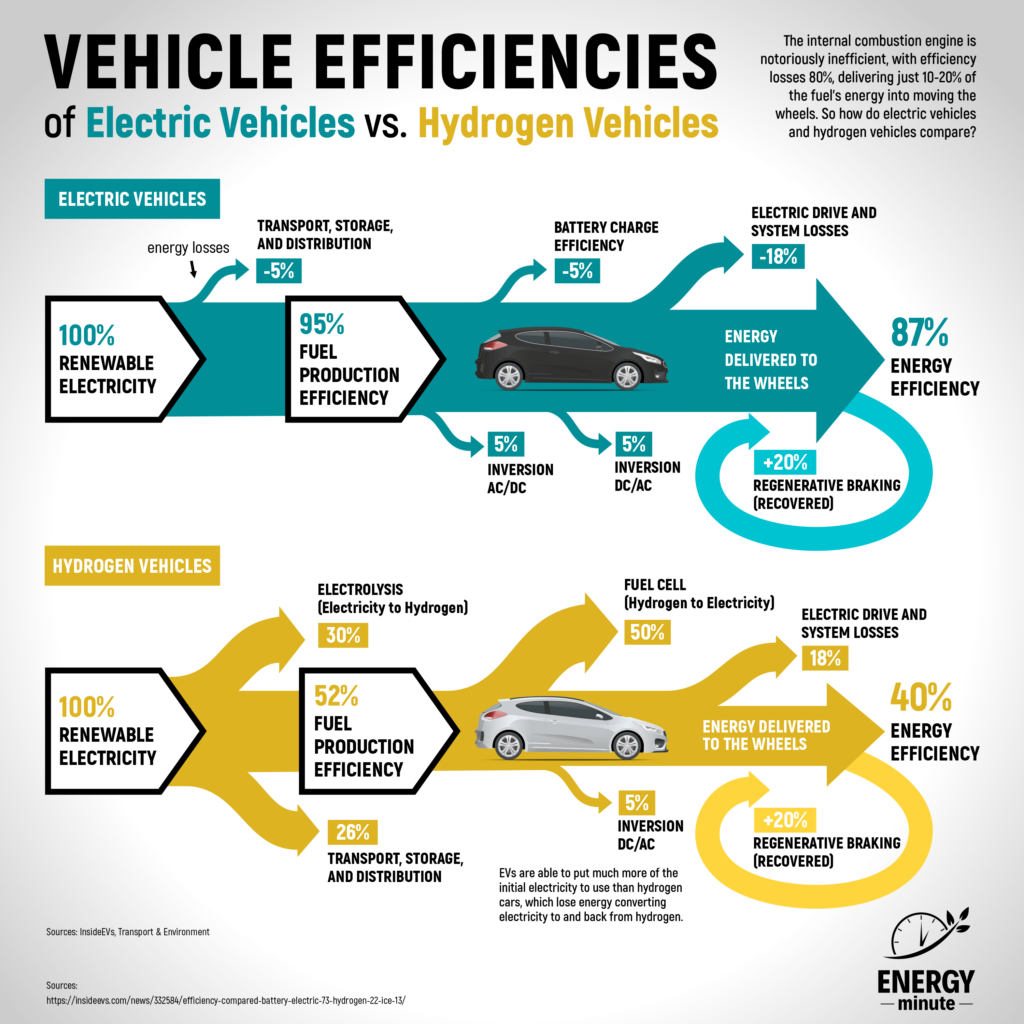
Courtesy of ENERGYminute
See more articles and infographics from ENERGYminute HERE
Electric vehicles (EVs) and fuel cell vehicles (FCVs) are both considered part of the broader category of “green vehicles” or “alternative fuel vehicles,” but they operate using different technologies and power sources.
Power Source
- Electric Vehicle (EV): An electric vehicle is powered by electricity stored in a battery. The battery is recharged by plugging the vehicle into an electrical outlet or a charging station. The battery then supplies power to an electric motor, which drives the wheels and propels the vehicle.
- Fuel Cell Vehicle (FCV): A fuel cell vehicle, on the other hand, uses hydrogen gas as its primary fuel source. The hydrogen gas is stored in onboard tanks. In the fuel cell stack, hydrogen is combined with oxygen from the air to produce electricity through an electrochemical reaction. This electricity then powers an electric motor, which drives the vehicle.
Fueling/Charging Infrastructure
- EV: Electric vehicles require charging stations, which can be found in various locations, including homes, workplaces, public charging stations, and commercial areas. The charging process typically takes several hours, depending on the charging speed and the vehicle’s battery capacity.
- FCV: Fuel cell vehicles rely on hydrogen refueling stations to replenish their fuel supply. Hydrogen refueling infrastructure is less widespread compared to electric charging stations, making it less convenient for FCV owners to find refueling options in some regions.
Range
- EV: Electric vehicles’ range has been improving steadily with advancements in battery technology. Modern electric cars can achieve ranges of 200 to 300 miles (320 to 480 kilometers) or more on a single charge, depending on the model.
- FCV: Fuel cell vehicles also offer a decent range, typically comparable to or slightly better than electric vehicles. The range of FCVs can be between 300 to 400 miles (480 to 640 kilometers) on a full tank of hydrogen.
Environmental Impact
- EV: Electric vehicles produce zero tailpipe emissions since they don’t burn any fuel directly. However, the environmental impact of EVs depends on the electricity generation mix of the region where they are charged and where the batteries are made.
- FCV: Fuel cell vehicles also produce zero tailpipe emissions since the only byproduct of the hydrogen-to-electricity conversion is water vapor. However, the production of hydrogen itself may involve emissions, depending on the method used to obtain hydrogen (e.g., steam methane reforming or electrolysis using renewable energy sources).
Adoption and Market Availability
- EV: Electric vehicles have been more widely adopted than fuel cell vehicles, and there is a more extensive selection of electric car models available from various manufacturers.
- FCV: Fuel cell vehicles have seen slower adoption due to the limited availability of hydrogen refueling infrastructure, higher manufacturing costs, and other technological challenges.
Sources:
https://insideevs.com/news/332584/efficiency-compared-battery-electric-73-hydrogen-22-ice-13/
Share This:






